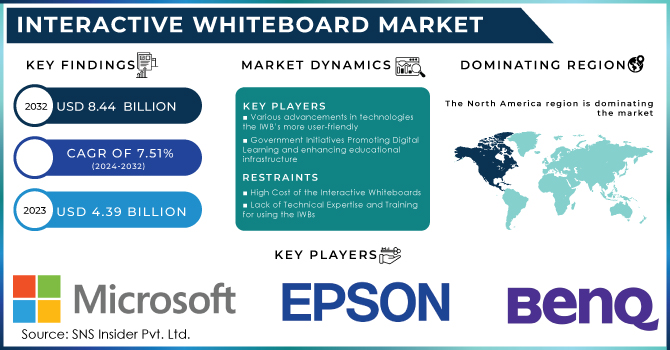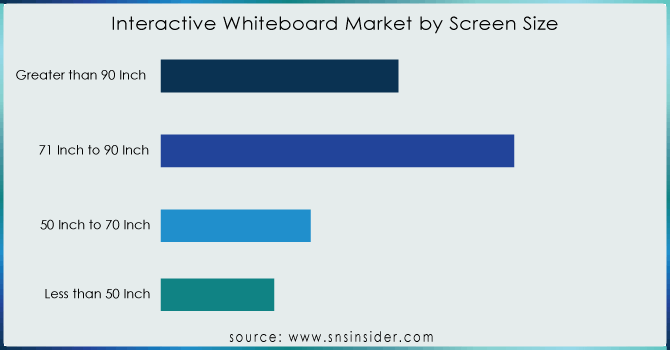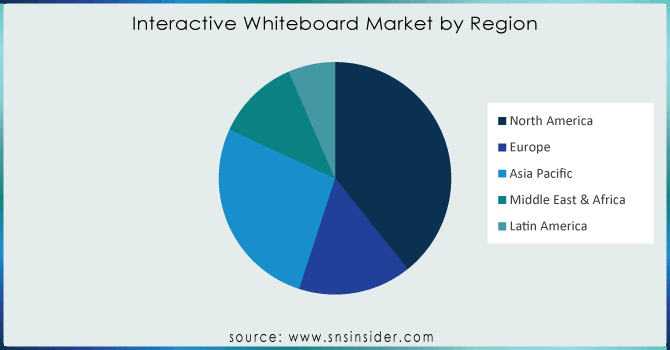Interactive Whiteboard Market Size:

Get more information on Interactive Whiteboard Market - Request Free Sample Report
The Interactive Whiteboard Market Size was valued at USD 4.39 billion in 2023 and is expected to reach USD 8.44 billion by 2032 and grow at a CAGR of 7.51% over the forecast period 2024-2032.
According to UNESCO, around 1.7 billion students were affected in 200 countries due to the shutdowns of schools during the COVID-19 outbreak. Digitalization in education took place to create a hassle-free study environment for its consumers. But in today’s era, it has become a need for every individual due to its rapid innovations and advancements like high-quality resolution touch screens, integration with artificial intelligence for adaptive learning, and support for augmented and virtual reality technologies. The growth of digital learning solutions in the education sector is a key factor that drives the interactive whiteboard market. Interactive whiteboards (IWBs), also known as smart boards, make classroom discussions more convenient for teachers and students because of the pictorial representation of the courses, fostering a more collaborative form of education. For Example, Promethean introduced the ActivPanel Elements series, designed to provide an intuitive and interactive learning experience.
The corporate sector's adoption of interactive whiteboards for virtual meetings, training programs, and remote working also presents significant growth opportunities. These digital whiteboards combine the similarities of physical presentations and the technology of computers. Interactive whiteboards allow for seamless integration of digital content, eliminate all the delays, and implement a smooth presentation. By integrating with video conferencing software, they ensure remote team members feel included. Everyone can access and interact with the same information on the screen, regardless of location. This fosters a more unified team experience and improves communication across geographical boundaries.
The development of portable and more affordable interactive whiteboards will also drive market growth, making these tools accessible to a broader audience. Many key players in the interactive whiteboard market have made contributions through new products and strategic mergers and acquisitions. For instance, SMART Technologies recently launched the SMART Board MX series, which features advanced collaboration tools and enhanced connectivity options. Similarly, Boxlight Corporation acquired Sahara Presentation Systems PLC to expand its product line and reach customers globally.
The interactive whiteboard market is poised for substantial growth, driven by the increasing adoption of digital learning in educational institutions and the need for various platforms for conducting meetings in corporate settings. The integration of different technologies and the development of cost-effective and accessible interactive whiteboards will further enhance market growth, backing up the role of interactive whiteboards in transforming education and corporate communication.
Interactive Whiteboard Market Dynamics:
Drivers
- Various advancements in technologies the IWB’s more user-friendly
The interactive whiteboard market is constantly evolving with new and innovative technologies. These advancements are making IWBs more user-friendly, feature-rich, and cost-effective, thereby increasing their appeal to a wider audience. Modern IWBs boast advanced touch recognition capabilities that allow for a more natural and intuitive user experience. Multi-touch functionality enables multiple users to interact with the board simultaneously, fostering collaboration and group activities. AI is making its way into IWBs, offering features like real-time handwriting recognition, voice recognition, and adaptive learning tools. These AI-powered features personalize the learning experience by tailoring content and activities to individual student needs. Cloud integration allows for easy access to learning materials, collaboration tools, and student data from anywhere. This enhances flexibility and facilitates remote learning scenarios effectively.
- Government Initiatives Promoting Digital Learning and enhancing educational infrastructure
Governments around the world are recognizing the potential of technology to improve education standards. Many countries are implementing initiatives to equip schools and educational institutions with digital learning resources, including interactive whiteboards. Focus on Improving Educational Outcomes: Governments aim to enhance student learning by promoting interactive and technology-driven learning methods. IWBs are seen as a valuable tool to achieve this goal. In some regions, there's a significant gap in access to educational technology between urban and rural areas. Government programs that provide IWBs to schools can help bridge this gap and ensure equitable access to quality education. By familiarizing students with interactive technology early on, governments are fostering innovation and technological literacy. For Example, In August 2023, BenQ launched EDLA-certified Smart Boards for Education with Google Mobile Services which is combined with the GMS ecosystem allowing users easy access to educational apps and resources.
Restraints
- High Cost of the Interactive Whiteboards
Despite the growing demand, the high cost of interactive whiteboards remains a major restraint for the market. Compared to traditional whiteboards, IWBs demand a high price. Many IWBs require a separate projector to display the interactive content. The cost of the projector can vary depending on its features and resolution. Setting up an IWB can be a complex process, especially for larger models. This often necessitates professional installation services, adding to the overall cost. IWBs typically require specialized software for operation and content management. These software licenses can be expensive, and ongoing maintenance costs need to be factored in as well. The high initial investment can be a major hurdle for schools and businesses, particularly those with limited budgets. This is especially true for smaller institutions and those located in economically disadvantaged regions.
- Lack of Technical Expertise and Training for using the IWBs
Getting maximum results from the integrated whiteboards also requires proper training of the users. Effectively integrating IWBs into teaching methodologies requires training for teachers which not only includes all the technical aspects of operating the IWB but also making useful strategies for making the most out of it. Schools and businesses may need to invest in additional technical support staff to resolve any issues that arise with the IWBs. The lack of readily available technical staff and training opportunities can be a major drawback for the users, decreasing the growth of the market.
Interactive Whiteboard Market Segment Overview:
BY TECHNOLOGY
The resistive touch segment is dominating the market with a market share of over 42.55% in 2023 due to its adaptability in various areas. Resistive screens respond immediately when touched by fingers, styluses, or even other objects. This versatility makes them perfect for a wide range of uses, from classrooms to business presentations to interactive kiosks in stores.
However, the capacitive segment is growing at a very steady rate in the forecasted period 2024 to 2032. Capacitive technology gives a highly responsive and accurate touch experience. This improved user experience is driving the demand for capacitive touchscreens in interactive whiteboards, used in schools, businesses, and more.
BY FORM
In 2023, the portable segment by form carries a major market share of around 53%. This is because people are increasingly looking for flexible and easy ways to learn and present data. With the portable IWBs teachers can teach from anywhere and corporate meetings can take place even remotely.
Demand for fixed interactive whiteboards is also increasing day by day, with a predicted CAGR rate of above 6.01% from 2024 to 2032. This growth is fueled by the increasing adoption of digital transformation initiatives across many industries. Fixed boards allow organizations to ditch paper and embrace digital workflows, streamlining processes and using digital content to boost productivity and efficiency.
BY TECHNIQUE
The front projection whiteboards segment is currently the market leader, holding over 63.6% share in 2023. These projections can be easily adapted for bigger screens, making them ideal for classrooms, auditoriums, and conference rooms where everyone can get a good view of the screen.
On the other hand, the rear projection whiteboards segment is expected to see competitive growth in the upcoming years from 2024 to 2032. These whiteboards offer an engaging user experience by projecting images from behind the screen which makes it more exciting for the users to look at the presentation going on in the screen.
BY SCREEN SIZE

Need any customization research on Interactive Whiteboard Market - Enquiry Now
Interactive Whiteboard Market Regional Anlaysis:
North America holds the largest share of the global interactive whiteboard market, driven by the adoption of these boards in educational institutions and businesses. The integration of interactive whiteboards with Learning Management Systems (LMS) is a major factor. This seamless integration allows educators to easily access and deliver content directly from their LMS, streamlining lesson planning and assessments.
Many European countries are prioritizing investments in educational technology to modernize their education systems and improve digital literacy. Government funding and incentives for integrating technology in classrooms encourage schools to adopt interactive whiteboards. The UK's ongoing digital transformation in education is driving the interactive whiteboard market followed by Germany and France. As technology becomes more integrated into classrooms, these boards are becoming essential tools for educators to improve student engagement and learning outcomes.
The Asia Pacific region has seen a surge in adopting student information systems and e-learning solutions. This trend is driven by technological advancements, rising internet penetration rates, and a growing focus on digital literacy and remote learning. As a result, educational institutions across the region are integrating these technologies to enhance the learning experience. The Chinese market offers a wide range of products from established manufacturers and innovative startups, catering to different needs in education and business settings. Japan is integrating interactive whiteboards with AR and VR technologies to create immersive learning experiences in education and corporate training. India's growing adoption of online education platforms is a major factor in the significant growth of its interactive whiteboard market.

Recent Development
-
In 2023, Samsung introduced Samsung Flip Pro which allows up to four users to write and draw simultaneously. Ans it also offers brush and pen mode for different writing styles.
-
In 2023, Avocor launched AV-65U, a budget-friendly interactive whiteboard with 4K resolution that offers 20-point multi-touch for smooth and responsive interaction. It also includes built-in software for writing, drawing, and highlighting content.
-
In 2022, SMART Technologies came up with kapp iQ, an interactive whiteboard with built-in computing power that runs Android 10 for access to a wide range of apps. It includes object recognition for easy manipulation of digital objects on the board.
KEY PLAYERS:
Some of the major players in the Interactive Whiteboard Market are BenQ Corporation, Epson, Microsoft, Google, Boxlight, Cisco Systems, Hitachi Ltd., Hon Hai Precision Industry Co. Ltd., Newline, Panasonic Corporation, Promethean Lts, Samsung, Ricoh, Hitachi, NEC Corporation, ViewSonic, Smart Technologies, and others.
| Report Attributes | Details |
|---|---|
| Market Size in 2023 | US$ 4.39 Billion |
| Market Size by 2032 | US$ 8.44 Billion |
| CAGR | CAGR of 7.51% From 2024 to 2032 |
| Base Year | 2023 |
| Forecast Period | 2024-2032 |
| Historical Data | 2020-2022 |
| Report Scope & Coverage | Market Size, Segments Analysis, Competitive Landscape, Regional Analysis, DROC & SWOT Analysis, Forecast Outlook |
| Key Drivers | • Various advancements in technologies the IWB’s more user-friendly • Government Initiatives Promoting Digital Learning and enhancing educational infrastructure |
| Restraints | • High Cost of the Interactive Whiteboards • Lack of Technical Expertise and Training for using the IWBs |

